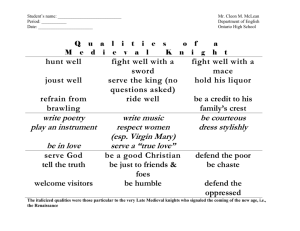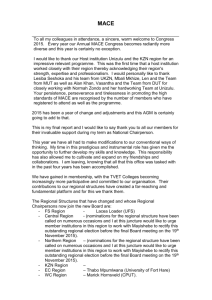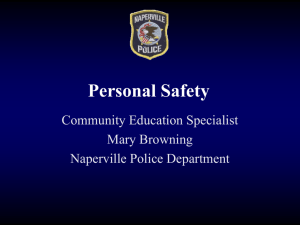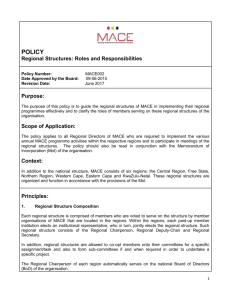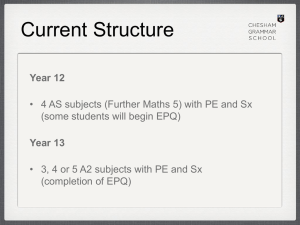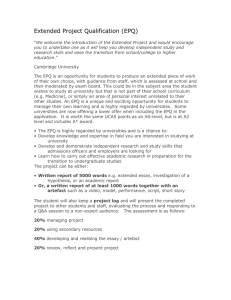Automated Theory Formation for Tutoring Tasks in Pure Mathematics
advertisement
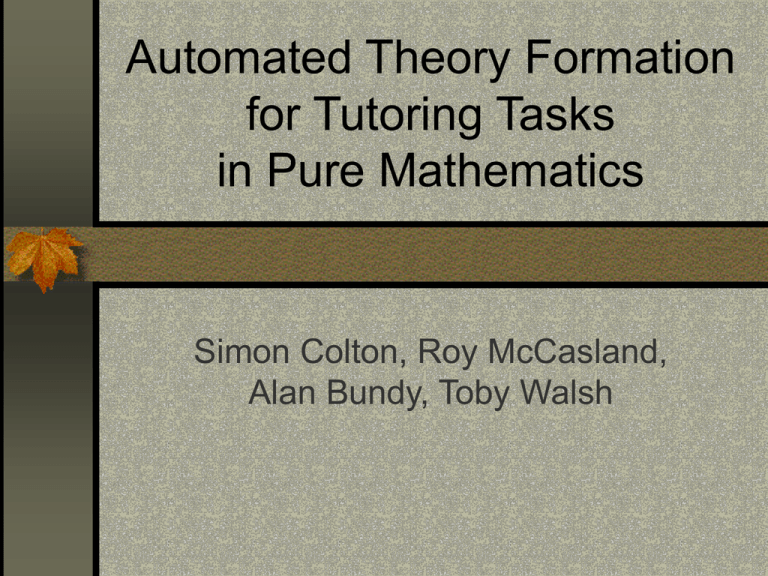
Automated Theory Formation for Tutoring Tasks in Pure Mathematics Simon Colton, Roy McCasland, Alan Bundy, Toby Walsh Tools for Maths Teachers Setting exercises is important in mathematics education Automated tools available for High school mathematics and below No tool available for University level Use ATF via the HR program As an aid to setting exercises Example in group theory The HR Program Automated theory formation Concepts, conjectures, proofs, counters Concept formation 10 production rules Conjecture making Find patterns empirically Settling conjectures Using Otter and MACE (and others) See CADE system description Group theory exercises In most text books/courses: Determining subgroups Negative results useful in learning process Example: centre of a group Elements which commute with all others Student has to show: Closure, associativity, identity, inverse Or: non-empty and a & b in Z a * b-1 in Z Approach using HR Use HR’s concept formation Find different types of element Flag those forming a subgroup empirically Use Otter To show that the subset forms a subgroup Use MACE To find a counterexample group Use (human) teacher Interpret results as exercises Improvements to HR #1 Embed Algebra PR Designed to be domain independent Find embedded algebraic structures In algebras, graphs, integers Any arity four concept Triples of subobjects possibly form algebra User sets algebras to look for HR abstracts subobjects into Cayley table MACE used to check axioms HR checks isomorphism with previous MACE not asked to search (efficient) Improvements to HR #2 “Reactive” search Heuristic search Best first search BFS often better after delay Some PRs should be used sparingly E.g., disjunction, instantiation Other PRs should be used when poss E.g., embed algebra rule HR’s reactive search: after each step: Java code fragment read by HR Different to the paper Experimental Setup Groups up to order 8 (14 groups) Reaction to new element type Force use of embed-algebra Flag concepts forming non-trivial subgroups 10,000 theory formation step No proving or counterexample finding (fast) Any promising subgroup types Further investigate with Otter and MACE Pentium 4 (2.0 Ghz) under Windows XP Suggestions for Using Results If subgroup property is proved Ask student to prove this If known counterexamples Ask student to determine smallest Ask student to identify classes of group Ask student to characterise all groups Caveat These problems may be too difficult Results 301 seconds to finish search 330 concepts 17 element types found 10 produced subgroups empirically 8 were non-trivial Look now at two element types in detail Concept g93 [a,b] : all c (exists d (d*c=b & c*d=b)) Actually defines centre of group (paper) HR often comes up with usual definition Empirically true, can we prove it? Otter employed for three tests: Closure of: identity, inverse, multiplication 0.2 secs, 25 secs, 55 secs Obvious interpretation for tutorial Nice to see historically interesting result Concept g43 [a,b] : exists c (c*c = b) Diagonal elements on Cayley table Groups up to order 8: forms a subgroup Fairly certain not in general case Suggested trying to disprove first Passed MACE: axioms, g43 definition And multiplicative closure property 143 seconds later, MACE produced: Smallest(?) “Bad” group for concept g43 * | 0 1 2 3 4 5 6 7 8 9 10 11 --+-----------------------------------0 | 0 1 2 3 4 5 6 7 8 9 10 11 1 | 1 0 3 2 5 4 7 6 9 8 11 10 2 | 2 3 4 5 0 1 8 9 10 11 6 7 3 | 3 2 5 4 1 0 9 8 11 10 7 6 4 | 4 5 0 1 2 3 10 11 6 7 8 9 5 | 5 4 1 0 3 2 11 10 7 6 9 8 6 | 6 7 10 11 8 9 1 0 5 4 3 2 7 | 7 6 11 10 9 8 0 1 4 5 2 3 8 | 8 9 6 7 10 11 3 2 1 0 5 4 9 | 9 8 7 6 11 10 2 3 0 1 4 5 10 | 10 11 8 9 6 7 5 4 3 2 1 0 11 | 11 10 9 8 7 6 4 5 2 3 0 1 Possible Use of Concept g43 Could ask student to find MACE’s c-ex. Alternatively: Ask for a subclass of groups with property (Example Abelian groups) Ask for a characterisation (honors) See Appendix A of paper For 10 tutorial questions which arose Other ways to use results Some subsets of elements are contained In other subsets of elements Both sets identified by HR (and the conjecture) Intuition of students Mathematicians use minimal hypotheses HR sometimes produces conjectures: With non-minimal and/or convoluted hypotheses Useful for students to prove theorems with nonminimal or convoluted hypotheses b*c=d & d*b=c & d*d=b inv(c)=d Conclusions and Future Work Performed an initial feasibility study HR, Otter, MACE help with maths tutorials Example in group theory Novel questions arose from non-human results Possible to use HR semi-automatically Maybe HR used as a tool in future

